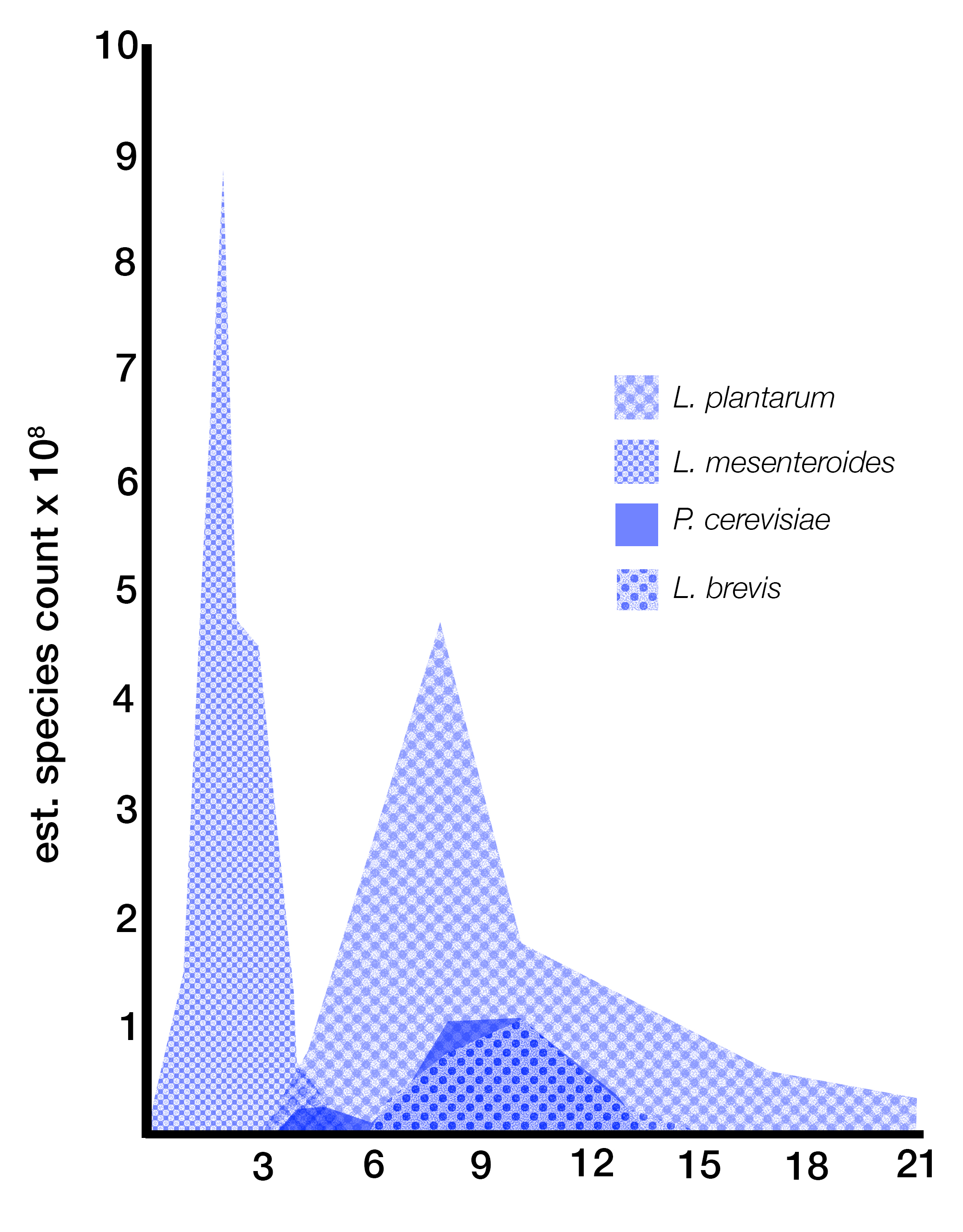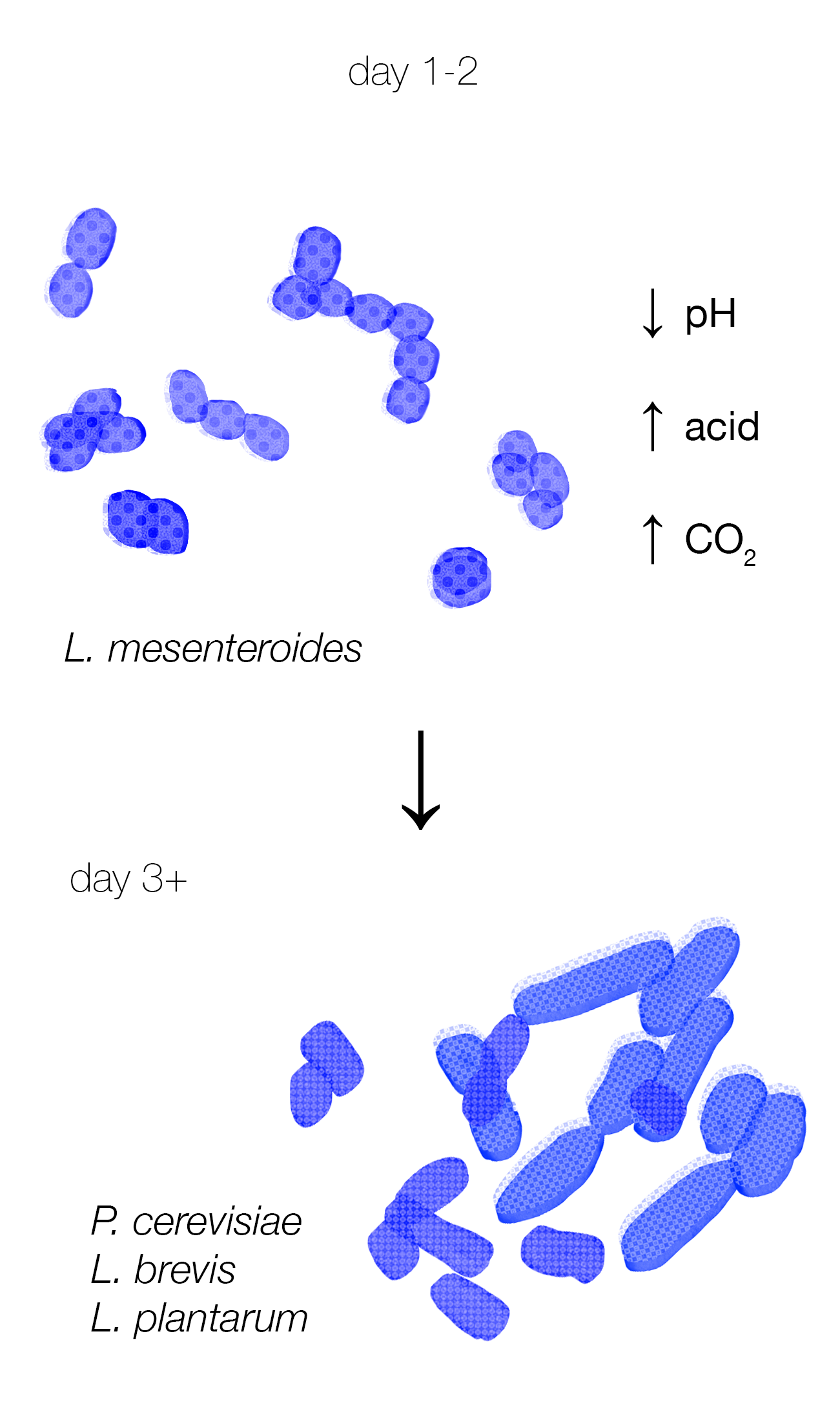Sauerkraut
Fermented cabbage
Ingredients: common cabbage, salt
Taste: primarily acidic, pickley, and salty, can be slightly sweet
Popular in: Northern/Eastern Europe
Time: 2-4 weeks
Dominant microbes: Lactic acid producers
Tools: crock/jar, weight
sau·er·kraut
/ˈsou(ə)rˌkrout/
/ˈsou(ə)rˌkrout/
“Sauerkraut: The product, of characteristic acid flavor, obtained by the full fermentation, chiefly lactic, of properly prepared and shredded cabbage in the presence of not less than 2 percent nor more than 3 percent of salt. It contains, upon completion of the fermentation, not less than 1.5 percent of acid, expressed as lactic acid. Sauerkraut which has been rebrined in the process of canning or repacking, contains not less than 1 percent of acid, expressed as lactic acid.”
Food Inspection Decision (F.I.D.) 196, issued August 1925
Recipe:
Basic Sauerkraut
Ingredients
common cabbage
kosher salt
common cabbage
kosher salt
Tools
mixing bowl
clean jar with lid or crock
kitchen scale
fermentation weight
knife or mandolin
mixing bowl
clean jar with lid or crock
kitchen scale
fermentation weight
knife or mandolin
common cabbage
| Brassica oleracea var. capitata f. alba or green cabbage (but feel free to use any member of the capitata variety) is commonly used. It is a cool season crop, which is why sauerkraut is more popular in cooler climates. |
- Rinse the cabbage and remove any damaged leaves
- Remove the core, slice thinly with a knife or a mandolin
- Weigh the cabbage, and add 2% salt by weight
- Mix the cabbage and salt well in a bowl, until cabbage is wilty and water can be easily squeezed out; you can let it sit in the bowl, covered for 30min
- Pack the salted cabbage in the jar, pressing it down so that brine covers the surface (none of the cabbage solids should be exposed to air)
- Add the fermentation weight on top , and cover the jar with a loose lid
- Ferment at room temperature for 7-10 days. On day 7 taste the sauerkraut. If you think it’s ready, move it to the fridge; otherwise, keep fermenting!
kosher salt
Kosher salt is made without iodine, and has lower amount of minerals other than sodium when compared to other salts. While adequate iodine intake is essential for human nutrition, iodine is also antimicrobial, so using iodized salts may slow or inhibit fermentation.
Kosher salt is made without iodine, and has lower amount of minerals other than sodium when compared to other salts. While adequate iodine intake is essential for human nutrition, iodine is also antimicrobial, so using iodized salts may slow or inhibit fermentation.
fermentation math
What is 2% salt by weight?
Weight out the cabbage using a kitchen scale, then multiply the weight in grams by 0.02.
Add the resulting amount in kosher salt.
For example, 1000g of cabbage, 2% salt would be 20g of kosher salt
1000g * 0.02 = 20g
sauerkraut microbiology
Key microbes
Streptococcus faecalis
Leuconostoc mesenteroides
Lactobacillus brevis
Pediococcus cerevisiae
Lactobacillus plantarum
Bacterial Flora in Sauerkraut
23°C in 2.25% NaCl

Figure adapted from:
Pederson, Carl S., and Margaret N. Albury. "Bulletin: number 824: the sauerkraut fermentation." (1969)
Pederson, Carl S., and Margaret N. Albury. "Bulletin: number 824: the sauerkraut fermentation." (1969)

In the first one to two days of sauerkraut fermentation, heterolactic species like L. mesenteroides, which thrives in the salty environment, produces lactic acid, acetic acid, and carbon dioxide, decreasing the pH and outcompeting undesirable microorganisms that might spoil the ferment. The new acidic environment formed by heterolactic species promotes the growth of more acid tolerant homolactic Lactobacillaceae, including L. plantarum, and P. cerevisiae, as heterolactic species decrease.
Zabat, Michelle A., et al. “Microbial community analysis of sauerkraut fermentation reveals a stable and rapidly established community.” Foods 7.5 (2018): 77.
Pederson, Carl S., and Margaret N. Albury. “Bulletin number 824: the sauerkraut fermentation.” (1969).
Zabat, Michelle A., et al. “Microbial community analysis of sauerkraut fermentation reveals a stable and rapidly established community.” Foods 7.5 (2018): 77.
Pederson, Carl S., and Margaret N. Albury. “Bulletin number 824: the sauerkraut fermentation.” (1969).
Sauerkraut fermentation is never limited to these four members. Weissella spp., Lactobacillus coryniformis, Lactobacillus curvatus, Lactobacillus sakei, Lactococcus lactis subsp. lactis, and Leuconostoc fallax have also been identified in sauerkraur (Plengvidhya et al. 2007), with more species identified as out culturing and sequencing methods improve, as as we collect samples from a wider geography.
Plengvidhya, Vethachai, et al. "DNA fingerprinting of lactic acid bacteria in sauerkraut fermentations." Applied and Environmental Microbiology 73.23 (2007): 7697-7702.
heterolactic
produces a variety of fermentation end products, including lactic acid, acetic acid (among other acids), as well as ethanol, carbon dioxide
homolactic
produces primarily lactic acid, resulting from a 1:2 conversion of glucose:lactic acid, and leading to a greater ATP yield than heterolactic fermentation
produces a variety of fermentation end products, including lactic acid, acetic acid (among other acids), as well as ethanol, carbon dioxide
homolactic
produces primarily lactic acid, resulting from a 1:2 conversion of glucose:lactic acid, and leading to a greater ATP yield than heterolactic fermentation